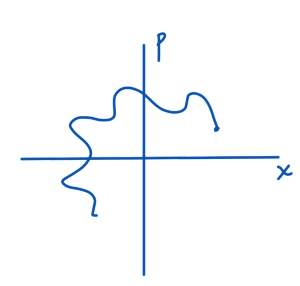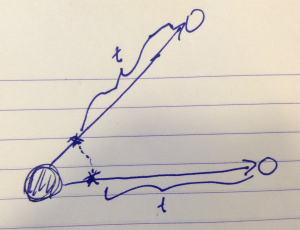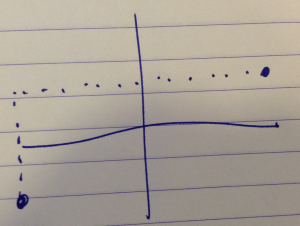[Click here for a PDF of this post with nicer formatting]
Disclaimer
Peeter’s lecture notes from class. These may be incoherent and rough.
These are notes for the UofT course PHY1520, Graduate Quantum Mechanics, taught by Prof. Paramekanti, covering [1] chap. 1 content.
Classical mechanics
We’ll be talking about one body physics for most of this course. In classical mechanics we can figure out the particle trajectories using both of \( (\Br, \Bp \), where
\begin{equation}\label{eqn:qmLecture1:20}
\begin{aligned}
\ddt{\Br} &= \inv{m} \Bp \\
\ddt{\Bp} &= \spacegrad V
\end{aligned}
\end{equation}
A two dimensional phase space as sketched in fig. 1 shows the trajectory of a point particle subject to some equations of motion

fig. 1. One dimensional classical phase space example
Quantum mechanics
For this lecture, we’ll work with natural units, setting
\begin{equation}\label{eqn:qmLecture1:480}
\boxed{
\Hbar = 1.
}
\end{equation}
In QM we are no longer allowed to think of position and momentum, but have to start asking about state vectors \( \ket{\Psi} \).
We’ll consider the state vector with respect to some basis, for example, in a position basis, we write
\begin{equation}\label{eqn:qmLecture1:40}
\braket{ x }{\Psi } = \Psi(x),
\end{equation}
a complex numbered “wave function”, the probability amplitude for a particle in \( \ket{\Psi} \) to be in the vicinity of \( x \).
We could also consider the state in a momentum basis
\begin{equation}\label{eqn:qmLecture1:60}
\braket{ p }{\Psi } = \Psi(p),
\end{equation}
a probability amplitude with respect to momentum \( p \).
More precisely,
\begin{equation}\label{eqn:qmLecture1:80}
\Abs{\Psi(x)}^2 dx \ge 0
\end{equation}
is the probability of finding the particle in the range \( (x, x + dx ) \). To have meaning as a probability, we require
\begin{equation}\label{eqn:qmLecture1:100}
\int_{-\infty}^\infty \Abs{\Psi(x)}^2 dx = 1.
\end{equation}
The average position can be calculated using this probability density function. For example
\begin{equation}\label{eqn:qmLecture1:120}
\expectation{x} = \int_{-\infty}^\infty \Abs{\Psi(x)}^2 x dx,
\end{equation}
or
\begin{equation}\label{eqn:qmLecture1:140}
\expectation{f(x)} = \int_{-\infty}^\infty \Abs{\Psi(x)}^2 f(x) dx.
\end{equation}
Similarly, calculation of an average of a function of momentum can be expressed as
\begin{equation}\label{eqn:qmLecture1:160}
\expectation{f(p)} = \int_{-\infty}^\infty \Abs{\Psi(p)}^2 f(p) dp.
\end{equation}
Transformation from a position to momentum basis
We have a problem, if we which to compute an average in momentum space such as \( \expectation{p} \), when given a wavefunction \( \Psi(x) \).
How do we convert
\begin{equation}\label{eqn:qmLecture1:180}
\Psi(p)
\stackrel{?}{\leftrightarrow}
\Psi(x),
\end{equation}
or equivalently
\begin{equation}\label{eqn:qmLecture1:200}
\braket{p}{\Psi}
\stackrel{?}{\leftrightarrow}
\braket{x}{\Psi}.
\end{equation}
Such a conversion can be performed by virtue of an the assumption that we have a complete orthonormal basis, for which we can introduce identity operations such as
\begin{equation}\label{eqn:qmLecture1:220}
\int_{-\infty}^\infty dp \ket{p}\bra{p} = 1,
\end{equation}
or
\begin{equation}\label{eqn:qmLecture1:240}
\int_{-\infty}^\infty dx \ket{x}\bra{x} = 1
\end{equation}
Some interpretations:
- \( \ket{x_0} \leftrightarrow \text{sits at} x = x_0 \)
- \( \braket{x}{x’} \leftrightarrow \delta(x – x’) \)
- \( \braket{p}{p’} \leftrightarrow \delta(p – p’) \)
- \( \braket{x}{p’} = \frac{e^{i p x}}{\sqrt{V}} \), where \( V \) is the volume of the box containing the particle. We’ll define the appropriate normalization for an infinite box volume later.
The delta function interpretation of the braket \( \braket{p}{p’} \) justifies the identity operator, since we recover any state in the basis when operating with it. For example, in momentum space
\begin{equation}\label{eqn:qmLecture1:260}
\begin{aligned}
1 \ket{p}
&=
\lr{ \int_{-\infty}^\infty dp’
\ket{p’}\bra{p’} }
\ket{p} \\
&=
\int_{-\infty}^\infty dp’
\ket{p’}
\braket{p’}{p} \\
&=
\int_{-\infty}^\infty dp’
\ket{p’}
\delta(p – p’) \\
&=
\ket{p}.
\end{aligned}
\end{equation}
This also the determination of an integral operator representation for the delta function
\begin{equation}\label{eqn:qmLecture1:500}
\begin{aligned}
\delta(x – x’)
&=
\braket{x}{x’} \\
&=
\int dp \braket{x}{p} \braket{p}{x’} \\
&=
\inv{V} \int dp e^{i p x} e^{-i p x’},
\end{aligned}
\end{equation}
or
\begin{equation}\label{eqn:qmLecture1:520}
\delta(x – x’)
=
\inv{V} \int dp e^{i p (x- x’)}.
\end{equation}
Here we used the fact that \( \braket{p}{x} = \braket{x}{p}^\conj \).
FIXME: do we have a justification for that conjugation with what was defined here so far?
The conversion from a position basis to momentum space is now possible
\begin{equation}\label{eqn:qmLecture1:280}
\begin{aligned}
\braket{p}{\Psi}
&= \Psi(p) \\
&= \int_{-\infty}^\infty \braket{p}{x} \braket{x}{\Psi} dx \\
&= \int_{-\infty}^\infty \frac{e^{-ip x}}{\sqrt{V}} \Psi(x) dx.
\end{aligned}
\end{equation}
The momentum space to position space conversion can be written as
\begin{equation}\label{eqn:qmLecture1:300}
\Psi(x)
= \int_{-\infty}^\infty \frac{e^{ip x}}{\sqrt{V}} \Psi(p) dp.
\end{equation}
Now we can go back and figure out the an expectation
\begin{equation}\label{eqn:qmLecture1:320}
\begin{aligned}
\expectation{p}
&=
\int \Psi^\conj(p) \Psi(p) p d p \\
&=
\int dp
\lr{
\int_{-\infty}^\infty \frac{e^{ip x}}{\sqrt{V}} \Psi^\conj(x) dx
}
\lr{
\int_{-\infty}^\infty \frac{e^{-ip x’}}{\sqrt{V}} \Psi(x’) dx’
}
p \\
&=\int dp dx dx’
\Psi^\conj(x)
\inv{V} e^{ip (x-x’)} \Psi(x’) p \\
&=
\int dp dx dx’
\Psi^\conj(x)
\inv{V} \lr{ -i\PD{x}{e^{ip (x-x’)}} }\Psi(x’) \\
&=
\int dp dx
\Psi^\conj(x) \lr{ -i \PD{x}{} }
\inv{V} \int dx’ e^{ip (x-x’)} \Psi(x’) \\
&=
\int dx
\Psi^\conj(x) \lr{ -i \PD{x}{} }
\int dx’ \lr{ \inv{V} \int dp e^{ip (x-x’)} } \Psi(x’) \\
&=
\int dx
\Psi^\conj(x) \lr{ -i \PD{x}{} }
\int dx’ \delta(x – x’) \Psi(x’) \\
&=
\int dx
\Psi^\conj(x) \lr{ -i \PD{x}{} }
\Psi(x)
\end{aligned}
\end{equation}
Here we’ve essentially calculated the position space representation of the momentum operator, allowing identifications of the following form
\begin{equation}\label{eqn:qmLecture1:380}
p \leftrightarrow -i \PD{x}{}
\end{equation}
\begin{equation}\label{eqn:qmLecture1:400}
p^2 \leftrightarrow – \PDSq{x}{}.
\end{equation}
Alternate starting point.
Most of the above results followed from the claim that \( \braket{x}{p} = e^{i p x} \). Note that this position space representation of the momentum operator can also be taken as the starting point. Given that, the exponential representation of the position-momentum braket follows
\begin{equation}\label{eqn:qmLecture1:540}
\bra{x} P \ket{p}
=
-i \Hbar \PD{x}{} \braket{x}{p},
\end{equation}
but \( \bra{x} P \ket{p} = p \braket{x}{p} \), providing a differential equation for \( \braket{x}{p} \)
\begin{equation}\label{eqn:qmLecture1:560}
p \braket{x}{p} = -i \Hbar \PD{x}{} \braket{x}{p},
\end{equation}
with solution
\begin{equation}\label{eqn:qmLecture1:580}
i p x/\Hbar = \ln \braket{x}{p} + \text{const},
\end{equation}
or
\begin{equation}\label{eqn:qmLecture1:600}
\braket{x}{p} \propto e^{i p x/\Hbar}.
\end{equation}
Matrix interpretation
- Ket’s \( \ket{\Psi} \leftrightarrow \text{column vector} \)
- Bra’s \( \bra{\Psi} \leftrightarrow {(\text{row vector})}^\conj \)
- Operators \( \leftrightarrow \) matrices that act on vectors.
\begin{equation}\label{eqn:qmLecture1:420}
\hat{p} \ket{\Psi} \rightarrow \ket{\Psi’}
\end{equation}
Time evolution
For a state subject to the equations of motion given by the Hamiltonian operator \( \hat{H} \)
\begin{equation}\label{eqn:qmLecture1:440}
i \PD{t}{} \ket{\Psi} = \hat{H} \ket{\Psi},
\end{equation}
the time evolution is given by
\begin{equation}\label{eqn:qmLecture1:460}
\ket{\Psi(t)} = e^{-i \hat{H} t} \ket{\Psi(0)}.
\end{equation}
Incomplete information
We’ll need to introduce the concept of Density matrices. This will bring us to concepts like entanglement.
References
[1] Jun John Sakurai and Jim J Napolitano. Modern quantum mechanics. Pearson Higher Ed, 2014.
Like this:
Like Loading...



